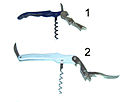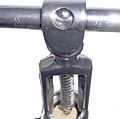corkscrew
A corkscrew or Austrian stubble puller , Swiss tenon puller (outdated also called cork puller or stopper puller ) is a tool that comes in many different designs and is used to uncork bottles . The most common type, the simple corkscrew, has a metal screw spindle or a coiled thin metal rod. The cross handle attached to it represents the turning and pulling device. The bottle cork is the most widespread type of closure next to the screw cap and crown cap.
History and meaning
The corkscrew developed at the end of the 17th century when glass bottles were increasingly used for storage in England. Not only wine was filled in, but also other liquids (perfume, beer, etc.) and all kinds of solids (herbs, spices, etc.). It was therefore necessary to develop a tool in order to be able to remove the cork stopper effectively and gently for the glass and stored goods. It is assumed that the manufacture of the first corkscrews was inspired by the spindle drill of the stuffing box puller - a cleaning instrument for firearms. The first patent was filed by Rev. Samuel Henshall of Oxford in 1795.
Since then, manufacturers have been developing corkscrews of all kinds with widely varying designs and many technical refinements. It is not uncommon for them to be provided with symbols of various origins and are now produced, among other things, as promotional gifts. And so it is not surprising that, similar to pocket knives, they became cult and collector's items - the corkscrew collectors are called pomelkophiles (“poma”: stopper; “elken”: pull; “philos”: friendly). The first German association for corkscrew collectors, "Verein Korkenzieherfreunde", was founded in 1996.
The Museum of Corkscrews in Provence , for example, provides a diverse overview of the history and importance of corkscrews . There, in the Luberon near the town of Ménerbes and set up in a winery, more than 1000 different corkscrews from a private collection can be viewed.
species
There are numerous types of corkscrews with different mechanisms for reducing the effort. The following types represent only a selection of the variety.
T-corkscrew
The T-corkscrew is the oldest and most common variant and consists of a helix or a screw with a tip that is attached to the cross handle. The coil is twisted into the cork and pulled out of the bottle neck by hand with a vertical pulling motion. Since there are considerable mechanical forces acting on the handle, it is mostly made of resistant material such as wood, metal, bone or horn. A modern corkscrew has a Teflon-coated spiral with a core, i.e. the spiral winds around a cavity in the middle of the corkscrew.
The simple corkscrew is often part of pocket knives or multifunctional tools or is itself provided with accessories that support opening the bottle. You can find corkscrews with bottle openers, pocket cutlery, spurs, knives (to cut the foil), wax breakers or brushes.
Waiter's knife
The capsule is first cut off at the neck of the bottle with a small knife . The spindle is then placed at a slight angle in the center of the cork. Then it is straightened up and turned in as far as possible. The lever is attached to the neck of the bottle so that the cork is gently and quickly transported out of the bottle with the help of the lever effect.
In the catering industry, this model or variations of it are used almost exclusively. In the upscale gastronomy, specially trained sommeliers look after the respective wine cellars and usually have their own special sommelier knives, very similar in design to the waiter's knife shown, only much more elegant and noble in processing.
The German Carl FA Wienke had this invention patented in 1883.
Table and lever corkscrews
The table corkscrew is firmly attached to the table or worktop. The bottle is pressed against the corkscrew from below. The lever is moved forward, the spindle digging into the cork. In the last step, the lever is pulled back and the cork loosens from the bottle.
The table corkscrew is suitable for opening a large number of bottles in quick succession.
The way the lever corkscrew works is the same as that of the table corkscrew. The difference is that the lever corkscrew is a mobile handheld device. It has a pincer-like device that is used with one hand to hold the bottle in place. The lever is operated with the other hand.
Wing and scissor corkscrews
The wing corkscrew is an easy to use corkscrew. First, the ring (also called "bell" or "cage") is placed on the neck of the bottle. The spindle is screwed into the cork until the ring is tight, with the levers (wings) moving upwards on both sides. Then the wings are pressed down, which pulls the cork out over the thread.
With a scissor corkscrew , the cutting edge is screwed in as usual until the ring touches the edge of the bottle, with the multiple scissors mechanism in the upper part being folded up for this time. To pull out the cork, pull the handle above the scissor mechanism.
Pulling out the cork is much easier than with a simple corkscrew due to the reduction in weight.
As with the waiter's knife, the advantage of these models is that they save energy. You use the lever law to reduce the effort.
Overpressure corkscrew
With the overpressure corkscrew, a hollow needle is pushed through the cork into the bottle. Gas (e.g. air) is transported through this hollow needle into the bottle, creating an overpressure that pushes the cork out of the bottle.
There are two options for generating the overpressure:
- The corkscrew is equipped with a gas cartridge. Since a gas cartridge is only sufficient for opening a few bottles, significant operating costs are to be expected in this case.
- The corkscrew includes an air pump.
There is a risk of injury from improper use.
The positive pressure corkscrew was used in 1978 as a murder weapon in an episode of the well-known Columbo series by injecting a deadly poison into the wine bottle through the hollow needle during the opening process.
Bell corkscrew
Variant 1 : The spindle is turned into the cork with the T-handle. When it is completely screwed in, a switching mechanism switches the twist grip at the upper end to the thread and the cork is pulled out.
Variant 2 : The spindle is turned into the cork with the upper cross handle. When it is completely screwed in, the cork is pulled out through the thread with the help of the lower cross handle.
Variant 3 of the bell corkscrew does not contain two types of thread, but only a continuous Teflon-coated cutting edge "with a core", ie a helix. After putting it on, first turn the coil into the cork until the bell hits. As the coil continues to rotate through the cork, this coil then pulls the cork out of the bottle.
Spring-tongued corkscrew
The spring tongues or clasp corkscrews consist of two tongues of different lengths made of spring steel, spaced the width of a bottle neck on the inside. First, the tongues are placed on the right and left between the cork and the bottle neck. These are then moved in a rocking motion between the cork and neck and then twisted out of the bottle under tension. The spring-tongued corkscrew is not particularly suitable for plastic corks.
With the spring-tongued corkscrew you can not only remove a cork, but also put it back in the bottle. To do this, it is screwed into the bottle with the aid of the device and pulled out in a rocking motion without the cork. The cork remains undamaged.
General information on the corkscrew
- The free space in the middle of the coil is called the "soul". This construction is designed to avoid just drilling a hole in the cork without taking it with you when you pull it out. Furthermore, the soul prevents the cork from crumbling. The coil should not pierce the cork at the bottom to prevent the cork from crumbling into the wine.
- The corkscrew should also work properly with plastic corks and pull them straight up out of the bottle with little effort.
- If the cork cannot be removed, the neck of the bottle can be cut off with port wine tongs .
See also
Individual evidence
- ^ Museum for corkscrews
- ↑ Patent corkscrew (German Patent and Trademark Office). Retrieved April 26, 2015 .
- ↑ Corkscrew: More design than function , on test.de, accessed on September 15, 2015
- ↑ Mord à la Carte , on icolumbo.de, accessed on September 15, 2015
Web links
- Seven catalog pages with corkscrews in the wholesale catalog of the former GB Wiss Söhne, Thuringia around 1925
- Virtual Corkscrew Museum (English)
- The history of the corkscrew (English)
- Musee du Tire-Bouchon (website of a French winery with a corkscrew museum; French)















